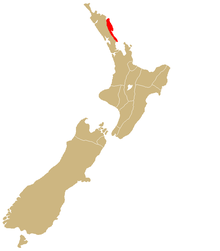Ngātiwai
| Ngātiwai | |
|---|---|
| Iwi of New Zealand | |
|
Whangarei Harbour | |
 | |
| Rohe (region) | Northland, Great Barrier Island, Little Barrier Island |
| Waka (canoe) | Māhuhu-ki-te-rangi or Ruakaramea |
Ngātiwai or Ngāti Wai is a Māori iwi of the east coast of the Northland Region of New Zealand. Its historical tribal area or rohe stretched from Cape Brett in the north to Takatū Point on Tawharanui Peninsula in the south and out to Great Barrier Island, the Poor Knights Islands and other offshore islands.[1]
Descendants of Ngātiwai include brothers Jim, Ian and Winston Peters, artist Shona Rapira Davies, and writer Paula Morris.
History
Early history
Ngātiwai trace their ancestry to the one of the earliest settlers of Te Tai-tokerau, Manaia, who was transformed into stone, with his family and servant Paekō atop of Mount Manaia in the Whāngārei Harbour. His descendant Manaia II, some 14 generations later, was the rangatira of Ngāti Manaia. Following a battle with Ngāpuhi at their pā at Mimiwhāngata, Ngāti Manaia fled out to sea, along the eastern coast, and on to the offshore islands. They became adept seafarers and were known as Ngātiwai-ki-te-moana under the leadership of Te Rangihōkaia and siblings Torematao and Te Rangapū.
Known for their ocean traditions and customs and coastal raiding, Ngātiwai ("descendants of the sea") were often accompanied by a guardian sea hawk or Tūkaiaia, where other tribes would be warned that Ngātiwai were on the move either at sea or on land.
Modern history
In April 2006, Ngātiwai sued the Department of Conservation over its handling of consultation issues in Northland regarding a marine reserve.[2]
See also
References
- ↑ "Rohe". tkm.govt.nz. Te Puni Kōkiri, New Zealand Government. Retrieved 2 March 2016.
- ↑ Article from the Independent